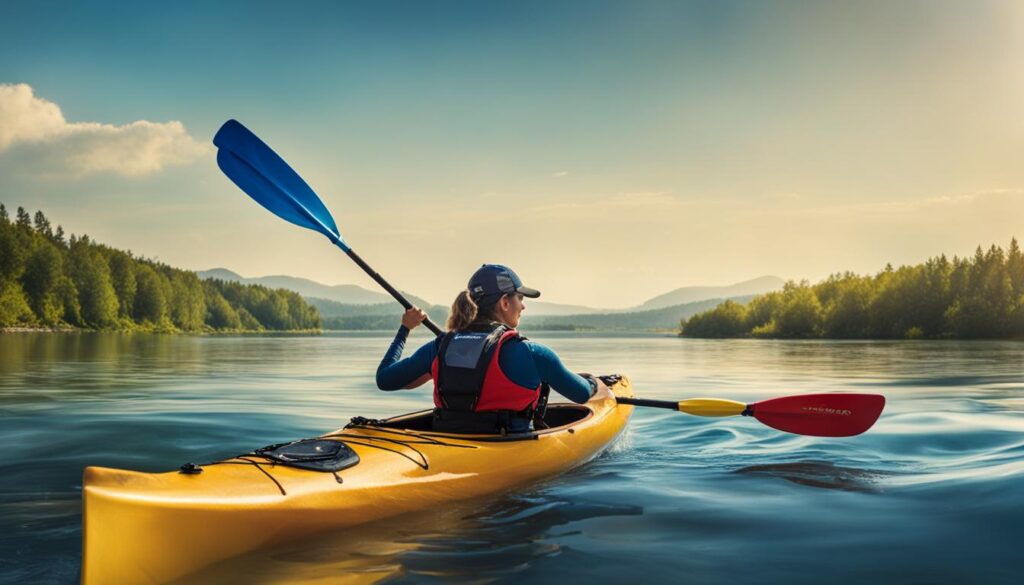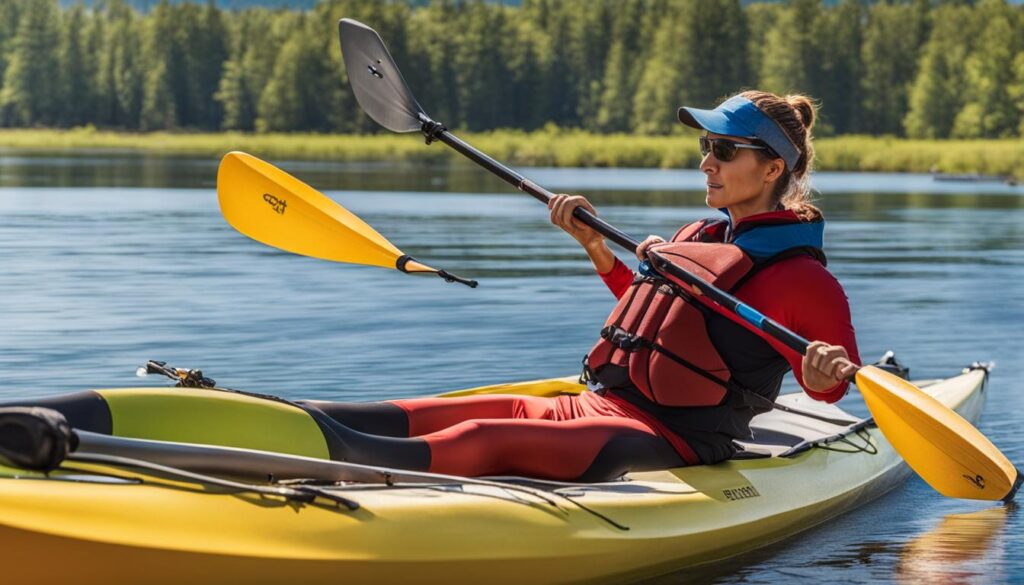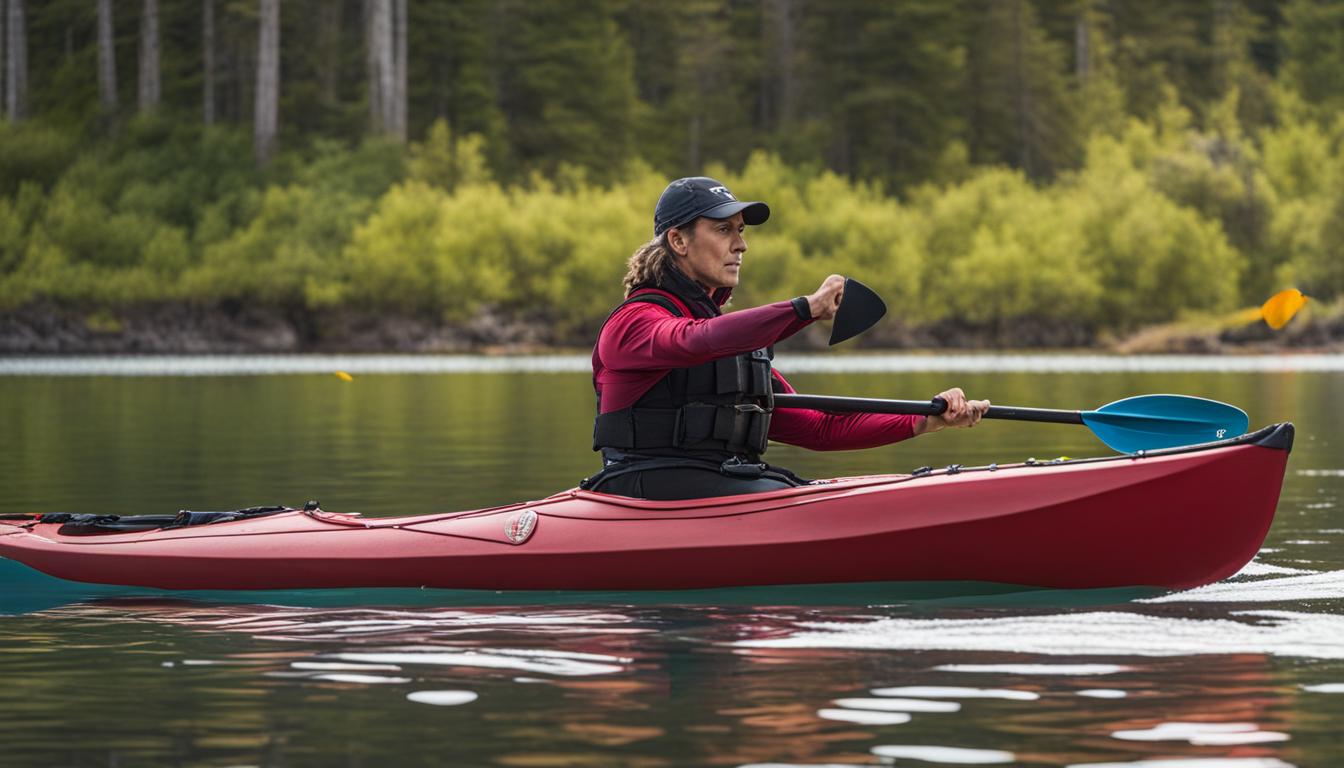Kayaking is an exhilarating outdoor activity that allows you to explore stunning waterways and embrace nature’s beauty. However, it’s essential to prioritize safety to prevent common injuries and ensure a enjoyable experience on the water. By following these expert tips and practicing safe paddling techniques, you can reduce the risk of injuries while indulging in the thrilling world of kayaking.
Key Takeaways:
- Develop flexibility, core strength, and upper body strength through exercises like progressive stretching and Pilates.
- Pay attention to proper technique and seek expert guidance to avoid acute injuries while getting in and out of the boat.
- Wear flat footwear with a good grip and keep your center of gravity low to prevent slips and falls.
- Incorporate exercises for strength and stability in your workout routine to reduce the risk of shoulder, wrist, and lower back injuries.
- Warm up and cool down properly before and after kayaking to prepare your muscles and joints and minimize the risk of injury.
Understanding Canoeing and Kayaking Injuries
Canoeing and kayaking are popular water sports that provide excitement and adventure. However, it’s important to be aware of the potential injuries that can occur during these activities. By understanding the types of injuries and taking proper precautions, you can minimize the risk and enjoy a safe kayaking experience.
Acute injuries are common when getting in and out of the boat, as well as during challenging maneuvers on the water. These injuries can include sprains, strains, and even fractures. Soft-tissue injuries are also prevalent due to the repetitive motions and unique forces applied to muscles and joints during paddling. The shoulder, wrists, fingers, and lower back are particularly vulnerable to these types of injuries.
To prevent these injuries, it’s crucial to develop flexibility, core strength, and upper body strength. Incorporating kayaking injury prevention exercises into your routine can help prepare your body for the demands of paddling. Progressive stretching, Pilates, and seeking guidance from experts can all contribute to injury prevention. Additionally, it’s essential to practice proper technique and seek professional instruction to ensure you are paddling in a safe and efficient manner.
Safeguarding Your Body: Common Kayaking Injuries and Prevention
To gain a deeper understanding of the injuries that can occur while canoeing or kayaking, let’s take a closer look at some common examples:
| Injury Type | Description | Prevention Tips |
|---|---|---|
| Shoulder Dislocation | Occurs when the head of the humerus bone pops out of the shoulder socket. | Strengthen the rotator cuff muscles, practice proper paddling technique, and warm up before paddling. |
| Wrist Tendinitis | An inflammation of the tendons in the wrist caused by repetitive motion and inadequate grip technique. | Strengthen wrist muscles, use proper grip technique, and incorporate wrist stretches into your warm-up routine. |
| Lower Back Strain | Pain and discomfort in the lower back due to improper posture and lack of core stability. | Improve core strength, maintain proper posture, and use a supportive kayak seat. |
By understanding the types of injuries that can occur while canoeing and kayaking, and taking preventive measures such as incorporating kayaking injury prevention exercises and practicing proper technique, you can reduce the risk of injury and make the most of your time on the water.
Key Steps for Injury Prevention in Canoeing and Kayaking
To prevent injuries while canoeing or kayaking on a regular basis, there are key steps you can take. By following these guidelines, you can minimize the risk of wrist and shoulder injuries, which are common in these sports.
Center of Gravity and Footwear
When getting in and out of the boat, it is important to keep your center of gravity low and step into the center line of the boat. This helps maintain stability and reduces the chances of losing balance and getting injured. Additionally, wearing flat footwear with a good grip is crucial to ensure proper footing and avoid slips or falls.
Boat Maintenance
Ensuring the dryness of the boat’s bottom is essential for injury prevention. A wet bottom can make the boat more slippery and increase the risk of accidents. Check the boat before each outing to ensure it is dry and free from any water or debris that could pose a hazard.
Strength and Flexibility
Developing strength and flexibility is vital for reducing the risk of injuries in canoeing and kayaking. Exercises that focus on the core, upper body, and wrist strength can help support the body and protect it from strain and injury. It is advisable to consult with a professional trainer or seek expert guidance to ensure proper form and technique during these exercises.

By following these key steps for injury prevention, you can enjoy canoeing and kayaking with peace of mind, knowing that you are taking the necessary precautions to protect yourself from wrist and shoulder injuries. Prioritizing safety, maintaining good technique, and staying in good physical condition are essential for a safe and enjoyable paddling experience.
Exercises for Strength and Stability in Paddle Sports
When it comes to enjoying kayaking and other paddle sports, incorporating exercises for strength and stability is crucial for reducing the risk of injuries. By improving your overall fitness and targeting specific muscle groups, you can enhance your paddling performance and stay injury-free on the water. Here are some key exercises to consider:
1. Rotator Cuff Strengthening
The rotator cuff plays a vital role in stabilizing your shoulder joint during paddling movements. To strengthen this area, you can perform exercises like external rotations using resistance bands or dumbbells. Start with light resistance and gradually increase as your strength improves. Aim for 2-3 sets of 10-15 repetitions.
2. Bilateral External Rotation
This exercise targets your shoulders and upper back. Stand with your arms bent at 90 degrees, elbows tucked in, and hold a resistance band or light dumbbells. Slowly rotate both arms outward, keeping your elbows close to your sides. Return to the starting position and repeat for 2-3 sets of 10-15 repetitions.
3. Single-Arm Bent-Over Row
This exercise focuses on your upper back and arms. Stand with your knees slightly bent, hinge forward at the hips, and hold a dumbbell in one hand. Pull the dumbbell towards your side, bending your elbow and squeezing your shoulder blade. Lower the weight back down and repeat on the opposite side. Aim for 2-3 sets of 10-15 repetitions on each side.
These exercises are just a starting point for building strength and stability in paddle sports. It’s important to consult with a fitness professional or physical therapist to ensure proper form and technique. Remember to start gradually and listen to your body to avoid overexertion. Stay consistent with your exercise routine, and you’ll notice improvements in your paddling performance and a reduced risk of injuries.
| Exercise | Targeted Muscles |
|---|---|
| Rotator Cuff Strengthening | Shoulders |
| Bilateral External Rotation | Shoulders, Upper Back |
| Single-Arm Bent-Over Row | Upper Back, Arms |
Warm-up and Cool-down Techniques for Injury Prevention
Before embarking on a kayaking adventure, it’s important to warm up your muscles and joints to minimize the risk of injury. A dynamic warm-up routine can increase blood flow and lubrication of the joints and soft tissues, preparing your body for the physical demands of paddling. Incorporate the following warm-up exercises into your pre-paddling routine:
- Standing overhead side bends with a paddle: Hold the paddle above your head with both hands and gently lean to each side, stretching the muscles along your torso.
- Standing trunk twists with a paddle: Hold the paddle across your chest and rotate your upper body from side to side, engaging the muscles in your core.
Perform each exercise for 1-2 minutes, gradually increasing the intensity as your muscles loosen up. Remember to listen to your body and avoid any movements that cause discomfort.
After your kayaking session, it’s equally important to cool down and stretch to promote muscle recovery and prevent stiffness. Engage in static stretches that target the major muscle groups used during paddling. Consider the following cool-down stretches:
- Hip flexor stretches: Step forward with one foot, keeping your back leg straight. Gently lean forward, feeling the stretch in the front of your hip. Hold for 30 seconds on each side.
- Hamstring stretches: Sit on the ground with one leg extended in front of you and the other bent. Reach forward and try to touch your toes, feeling the stretch in the back of your thigh. Hold for 30 seconds on each side.
- Internal rotator stretches using a paddle: Hold the paddle horizontally behind your back, grasping it with one hand at shoulder level. Gently press the paddle downward, feeling the stretch in your shoulder. Hold for 30 seconds on each side.
By incorporating these warm-up and cool-down techniques into your kayaking routine, you can minimize the risk of back pain and other common injuries associated with paddling. Prioritizing your body’s preparation and recovery will help you enjoy a safe and injury-free kayaking experience.

Incorporating Cardiovascular Endurance Training
When it comes to preventing injuries and enjoying safe kayaking sports, it’s important to not only focus on strength and stability exercises but also improve your cardiovascular endurance. Enhancing your cardio fitness will not only benefit your overall health but also contribute to a safer and injury-free paddling experience. By incorporating activities that get your heart rate up and challenge your cardiovascular system, you’ll be better prepared for the physical demands of kayaking.
One effective way to improve cardiovascular endurance is by engaging in activities such as swimming, rowing, or using cardio equipment at the gym. These exercises will help strengthen your heart and lungs, allowing you to paddle for longer durations without feeling fatigued. It’s essential to choose an activity that you enjoy and can commit to consistently, as consistency is key to reaping the benefits of cardio training.
By incorporating cardiovascular endurance training into your routine, you’ll not only reduce the risk of injuries but also enhance your overall performance on the water. You’ll be able to paddle longer distances, tackle more challenging routes, and enjoy the sport to the fullest. Remember to gradually increase the intensity and duration of your cardio workouts to avoid overexertion and give your body time to adapt. Always listen to your body and consult with a healthcare professional before starting any new exercise routine.
Benefits of Cardiovascular Endurance Training for Kayaking:
- Improved heart and lung function
- Increased stamina and endurance
- Enhanced oxygen delivery to muscles
- Reduced fatigue during long paddling sessions
- Improved recovery time
Remember, safe paddling techniques and injury prevention go hand in hand. By incorporating cardiovascular endurance training into your kayaking routine, you’ll not only reduce the risk of injuries but also enhance your overall performance and enjoyment of the sport.
Conclusion
By following expert tips for injury prevention, incorporating strength and stability exercises, warming up and cooling down properly, and improving cardiovascular endurance, you can minimize the risk of injuries while enjoying kayaking and other paddle sports. Prioritizing safety and maintaining good paddling techniques are key to ensuring an injury-free experience on the water. Remember to always consult with a healthcare professional before starting any new exercise routine. Stay safe and have fun paddling!
FAQ
What are some common injuries in canoeing and kayaking?
Acute injuries can occur when getting in and out of the boat, while soft-tissue injuries are common due to the unique forces exerted during paddling. The shoulder, wrists, fingers, and lower back are commonly affected.
How can I prevent injuries while canoeing or kayaking?
To prevent injuries, it is important to develop flexibility, core strength, and upper body strength through exercises like progressive stretching and Pilates. Additionally, keeping your center of gravity low when getting in and out of the boat, wearing flat footwear with a good grip, and ensuring dryness of the boat’s bottom are important guidelines for injury prevention.
What exercises can I do to improve strength and stability for paddle sports?
Exercises such as rotator cuff strengthening, bilateral external rotation, horizontal abduction, single-arm bent-over row, standing and single-leg balance, wood chops, palloff press, and side-lying plank with oblique twist can be beneficial for improving strength and stability in paddle sports.
How should I warm up and cool down before and after paddling?
A dynamic warm-up routine, including exercises like standing overhead side bends with a paddle and standing trunk twists with a paddle, increases blood flow and lubrication of the joints and soft tissues. Cooling down after paddling can be achieved through static stretches such as hip flexor stretches, hamstring stretches, and internal rotator stretches using a paddle.
How can I incorporate cardiovascular endurance training for safe paddling?
Activities like swimming, rowing, or using cardio equipment at the gym can improve cardiovascular fitness, which is essential for safe and injury-free paddling. Find an activity that you enjoy and can stick to consistently to improve your cardiovascular endurance.
What steps can I take to prevent injuries while kayaking?
By following expert tips for injury prevention, incorporating strength and stability exercises, warming up and cooling down properly, and improving cardiovascular endurance, you can minimize the risk of injuries while enjoying kayaking and other paddle sports.





